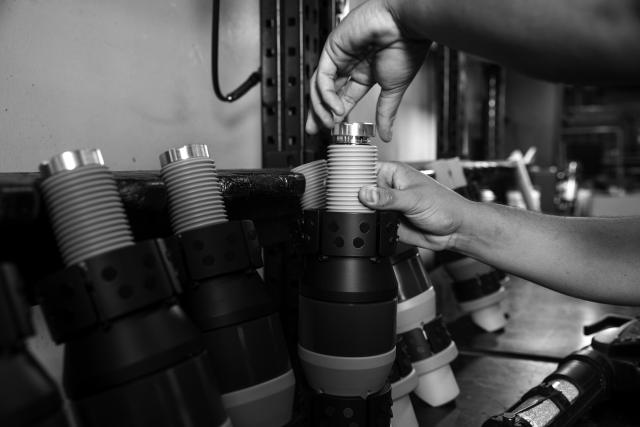
Changes in material for composite plugs will further reduce mill-out times and accompanying debris while providing the reliability necessary to hold the frac. (Source: Nine Energy Service)
[Editor's note: This story originally appeared in the January 2020 edition of E&P. Subscribe to the magazine here.]
As operators face increasing financial pressures within the evolving oil and gas market, reducing cycle times and improving profit margins have never been more critical. Project scopes are increasing to four, six and up to 14 or more well pads per site, requiring significant capital outlay upfront, which in turn squeezes operators to generate revenue faster to recoup their investment. Another trend on the rise is the drilling of longer laterals. While this can be an efficient way to develop acreage, it requires additional stages and, therefore, additional plugs.
To keep costs in check as project complexity grows, operators are scrutinizing all aspects of the drilling and completion process to identify potential savings. When it comes to frac plugs, faster drill-out times and the ability to bring product to the surface quickly positively impacts revenue and returns. As the needs of the field have progressed, so too has the evolution of the frac plug.
The first drillable frac plugs were made from cast iron. Although cast iron plugs met deployment requirements and pressure ratings, the time required to remove them was too long to be efficient at 15 to 25 minutes per plug. In addition to lengthy mill-out times, operators found it difficult to circulate cast iron out of the well, increasing the chance of getting stuck and the associated downtime.
Composite plugs
Given the challenges that cast iron plugs posed, the logical next step was to develop frac plugs using composite material with ceramic button slips to accelerate the millout process. With composites, well intervention—while still necessary—is less intrusive, as these plugs are easier to drill out and circulate out of the well. The advent of composite plugs has proved instrumental in the development and acceleration of the horizontal completion market over the past 15 years, especially as the number of wells per pad and plugs per well has increased.
Rather than millouts requiring as much as 25 minutes per plug, early composite frac plugs required only 10 to 15 minutes per plug. This evolved to mill-out times of just 6 to 10 minutes per plug, a marked improvement compared to cast iron.
In one 20,000-ft horizontal well in the Utica Basin, a northeast operator was able to drill out 144 Scorpion Composite plugs with an average drill time of 10 minutes per plug, with a single bit due to the shorter plug length and overall design. This saved the operator thousands of dollars by foregoing multiple bit trips.
However, using composite frac plugs in the toe stages of extended-reach horizontal wells poses a challenge due to the need to drill them out. To resolve this issue and support the increasing use of extended-reach horizontal wells, companies developed dissolvable plugs. Dissolvable frac plugs at the toe stages of extended-reach laterals eliminate the need to get coiled tubing (CT) to the bottom, which allows operators to produce wells much sooner. By eliminating the drillout of toe stages, dissolvable frac plugs have enabled the successful completion of extended-reach horizontal wells, which often exceed the practical range for use of CT or jointed tubing.
Interventionless options
Dissolvable plugs have significantly improved the economics of extended-reach horizontal wells. One operator in the Stack needed to employ an alternative to composite plugs because the well’s length eliminated the ability to use CT. By utilizing the Magnum Vanishing Plug, a dissolvable option, the operator was able to produce the well faster without drilling out a single plug or conducting a cleanout run, which is atypical for wells of its nature in the region. This resulted in significant savings in comparison to similar wells, reducing cycle time and the safety risks that come with well intervention. Ultimately, the operator was able to reduce its time to production after fracturing by 90%.

In another example, an operator with acreage in both the Marcellus and Permian basins wanted to ensure it could complete wells with ever-increasing lateral lengths while relying less on the limitations of the effective reach of CT. Using a Magnum Vanishing Plug suitable for various fluid compositions and bottomhole temperatures (BHT) ranging from 100 F to 300 F, the operator experienced the necessary durability during fracturing and the cleanout run showed complete dissolution. This provided a proven alternative to long-lateral intervention that the operator was able to apply to future wells.
The next evolution
The need for efficient production in extended-reach wellbores continues to spur the ongoing evolution of hydraulic stimulation. As technology companies continue to engineer frac plug advances, it has become clear that the ideal plug solution, whether composite or dissolvable, is dependent upon the well itself.
Operators must consider multiple factors when determining the right frac plug to keep costs controlled, minimize risk and maximize returns and revenues. Things to consider are BHT and how it changes during the completion, pressure requirements, chemistry of the frac fluid and the chloride content of the frac water. A one-size-fits-all approach sounds ideal in theory but ultimately doesn’t work in the field and can lead to inefficiencies that reduce profits.
To meet these needs, the next iteration of composite and dissolvable plugs will see noticeable changes and improvements that impact time and cost savings for operators. Early composite plugs were long and had many component parts, including cast iron slips. Today’s composites are typically between 12 in. and 22 in. long, but as operators’ demands continue to evolve, so will the dynamics of these plugs. Changes in material, length and durability will further reduce mill-out times and accompanying debris in the well while providing the reliability necessary to hold the frac. Plugs that can reliably hold the frac, expedite the cleanout run or eliminate the cleanout run completely allow operators to save more time and benefit from an increased return on investment.
Dissolvable frac plugs, popular in high-temperature shale plays such as the Eagle Ford, will continue to be a viable option for operators seeking to reduce time spent on post-frac millout as well as those zones in the lateral where composites can’t reliably be milled out due to CT limitations. Next-generation dissolvable frac plugs will see new design and material options that reduce costs for operators and promote more complete and reliable dissolution, while also allowing for use in different BHT environments and fluid compositions. The introduction of low temperature dissolvable material will give operators even greater flexibility.
Dissolvable frac plugs of the future also will afford operators greater timesavings and an increased rate of return while reducing HSE risks and associated service costs. Eliminating CT can save operators as much as 24 days per six-well pad in reduced drill-out time.
Additionally, as operators continue to focus on environmental, social and governance, dissolvable plugs aid in lowering their carbon footprint by reducing or eliminating diesel-powered equipment at the surface used during a mill-out operation.
Next-generation composite and dissolvable frac plugs will empower operators to have greater control over the economics of their well sites by providing access to new options, new designs and new materials. New technologies will help operators achieve their goals by taking a well’s unique dynamics into consideration. Increasing flexibility and customization in available options will help operators improve profit margins, speed time to production and improve safety.
Recommended Reading
Matador Stock Offering to Pay for New Permian A&D—Analyst
2024-03-26 - Matador Resources is offering more than 5 million shares of stock for proceeds of $347 million to pay for newly disclosed transactions in Texas and New Mexico.
Petrie Partners: A Small Wonder
2024-02-01 - Petrie Partners may not be the biggest or flashiest investment bank on the block, but after over two decades, its executives have been around the block more than most.
CEO: Coterra ‘Deeply Curious’ on M&A Amid E&P Consolidation Wave
2024-02-26 - Coterra Energy has yet to get in on the large-scale M&A wave sweeping across the Lower 48—but CEO Tom Jorden said Coterra is keeping an eye on acquisition opportunities.
CEO: Magnolia Hunting Giddings Bolt-ons that ‘Pack a Punch’ in ‘24
2024-02-16 - Magnolia Oil & Gas plans to boost production volumes in the single digits this year, with the majority of the growth coming from the Giddings Field.
E&P Earnings Season Proves Up Stronger Efficiencies, Profits
2024-04-04 - The 2024 outlook for E&Ps largely surprises to the upside with conservative budgets and steady volumes.





